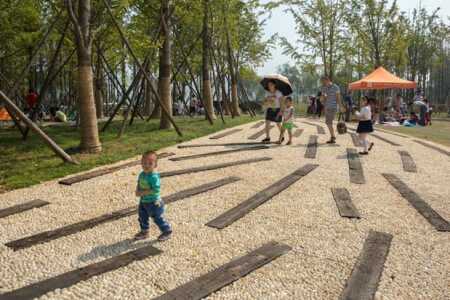Baxi River Forest IslandChangsha, Hunan Province, China
Project owner: Changsha Xiandao Land Development & Construction Co. Ltd.Designer: SWA GroupSize: 156 acres (63 ha), 2 miles long (3.2 km)
Changsha is a bustling city of 7 million people in China’s central Hunan province. The Baxi River meanders through the city, carrying water flows that have created 15 scattered islands near the city. Seasonal flooding, rapid water flow, and constructed monocultures have caused escalating erosion, destabilization, and loss of habitat along the banks. Past approaches to managing the river have favored the creation of hard edges to protect land and property.
With the two-mile-long (3.2 km), 156-acre (63 ha) Baxi River Forest Island, the local government tried a new approach. It embraced the river ecosystem, creating a new park that is helping both nature and people thrive.
The island park, designed by SWA, is able to withstand 18-foot (5.5 m) annual river level fluctuations with carefully calculated grading, terraces, and plantings. Native plants vary according to elevations of the island, changing from wetlands and marsh zones at the water’s edge to a seasonal forest at higher elevations. The diversity of flora and fauna increases the ecological resilience of the island as a whole.
The park honors the cultural traditions of the city and provides a place of respite and delight for Changsha’s growing population. An extensive trail, boardwalk, and bike path system offers access to the island’s wide variety of activities. In the seven-acre (2.8 ha) Wood Dragon Garden, a mythological creature associated with local water culture was the inspiration for a landscape built from recycled timber, local stone, and native plants. An interpretative center tells the story of the ancient river city. Miles of trails provide access to quiet meadows and shaded forest, a perfect sanctuary for meditation away from the prosperous city of Changsha.
Instead of fighting the river, designers used its flows and fluctuations as a catalyst, integrating strategies for land stabilization, water purification, and ecological revitalization with experiential and educational design elements. Designed as a pilot and prototype, the Baxi River Forest Island demonstrates the power of embracing the needs of both nature and people.
Baxi River Forest Island has transformed an island disturbed by flooding, erosion, and loss of habitat into a resilient and ecologically diverse park with vibrant gathering places that reconnect the people of Changsha to their river. It has become a destination for the city’s people, functioning as a large-scale nature exhibit, a central park for the growing city, and a symbol for local river culture.






